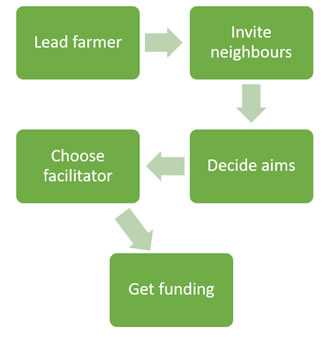Every farmer cluster story is different, but there are similar stages for each group. The first farmer clusters were formed with the steerage of GWCT farm advisors, but increasingly, farmers are setting up their own groups after hearing about the initiative from other farmers, the GWCT Farmer Cluster conference, agricultural media, regulators and policymakers.
A simple flow-chart illustrating the first steps of forming a farmer cluster:

1. Lead farmer
A Lead Farmer (or Chairman) is the steering member of the farmer cluster. They may be approached by an agricultural/environmental professional about starting a cluster, or decide to explore the idea for themselves having heard about it. Either way, there are several characteristics that make a great Lead Farmer:
- Well connected socially or professionally in their area
- Good ‘green’ credentials to set an example
- Knowledgeable about environmental issues
- Able to devote a good chunk of time to the farmer cluster
- Able to communicate well
2. Invite neighbours
By utilising friendships, business acquaintances/networks and other relationships, the Lead Farmer reaches out to potential farmer cluster members. The first gathering is usually somewhere informal like a household or local pub, and it is attended only by farmers at this stage. If an agricultural/environmental professional was involved from the start, they may play a part in this informal meeting.
3. Decide aims
If the prospective farmer members have agreed to form a cluster, a further meeting is arranged, by which time the farmer group will be taking shape and a geographical extent will be drafted. The following types of questions may be debated, and a framework of targets created:
- What issues do we have in common that are easier to address as a group?
- What species are iconic or declining in the area?
- What habitats do we have that we would like to enhance or extend?
- Can we improve the quality of the local watercourse and/or address flooding?
- Are there any ways in which we can collectively approach business/marketing?
- How can we reach out to local communities?
4. Choose facilitator
A cluster requires a facilitator to:
- Administrate the farmer cluster project
- Seek funding
- Organise activities and training
- Coordinate and oversee environmental work
This person must be chosen by the farmers themselves (or approval confirmed if they have been involved from the start). The chosen aims of the cluster will ultimately inform who is chosen to facilitate the group e.g. a catchment focussed group may choose to approach a Rivers Trust Officer, or a cluster with broad range of target wildlife species may choose to approach a FWAG advisor. In any case, the facilitator should be appropriately skilled and connected, preferably achieving or aspiring to meet an industry standard (such as the BASIS Certificate for Conservation Management).
5. Get funding
Most facilitators are in existing agricultural or environmental professions and enter into a Farmer Cluster project as part of their role. Depending on the size of the cluster, a facilitator may spend anywhere from a few hours to several days per week on the project. This time (and any expenses) must be funded, and there are different ways to seek the money required. The vast majority of groups are funded by the Natural England Countryside Stewardship Facilitation Fund, and an increasing number are being funded independently. See the Funding section for more information.
